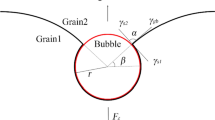Heterodiffusion processes or chemical reactions in heterogeneous media are initiated at contact points between dissimilar particles of the reagents. Therefore, the number of heterogeneous contacts in the starting mixture is assumed to determine the rate of these processes: in particular, the rate of mass transfer in self-propagating high-temperature synthesis. The conditions for obtaining structures with maximum heterogeneous contacts have not been clearly defined so far in the literature. The paper determines for the first time the optimal ratio of particle sizes for a two-component mixture. This ratio contributes to the starting mixture composition that involves the maximum number of dissimilar contacts at a given weight or volume content of the reagents. A model of two-component densely packed disordered biparticulate granular media is proposed. According to the model, the starting mixture is considered a random packing of spherical particles of two sizes. The particle size ratio has been established so that the number of heterogeneous contacts between the particles of different phases is the highest. The concept of an ideal reaction area, which is a biparticulate structure consisting of the maximum number of dissimilar particles, has been developed and the role of the starting particle size composition in the formation of such structure has been established. An algorithm is presented for calculating the characteristics of the starting mixture to promote the structure with ideal reaction areas.


Similar content being viewed by others
References
V.V. Skorokhod and S.M. Solonin, Physical Metallurgy Fundamentals for Powder Sintering [in Russian], Metallurgiya, Moscow (1984), p. 159.
G.F. Tavadze and A.S. Shteinberg, Production of Special Materials by Self-Propagating High-Temperature Synthesis [in Russian], Meridiani, Tbilisi (2011), p. 206.
G.F. Tavadze and D.V. Khantadze, “Considering structural heterogeneity in the synthesis of materials,” in: Proc. XIV Int. Symp. Self-Propagating High-Temperature Synthesis, Georgian National Academy Press, Tbilisi (2017), p. 332.
A.S. Rogachev and A.S. Mukasian, Combustion for the Synthesis of Materials: Introduction to Structural Macrokinetics [in Russian], Izd. Fiz. Mat. Tekh. Lit., Moscow (2012), p. 398.
D. Khantadze, Structural Models and Properties of Metallic Melts [in Russian], Forma, Tbilisi (2009), p. 160.
D.V. Khantadze, G.F. Tavadze, and A.S. Mukasyan, “Calculation of fractional composition of granular media providing maximum heterogeneous contacts,” in: Proc. III Int. Conf. Inorganic Materials Science Modern Technologies and Methods, Georgian National Academy Press, Tbilisi (2018), p. 120.
W. Schatt (ed.), Powder Metallurgy. Sintered and Composite Materials [in German], VEB Deutscher Verlag für Grundstoffindustrie, Leipzig (1975).
L. Fejes Tóth, Positioning in Plane, Sphere, and Space [in German], Springer (1953).
E.P. Baranovskii, “Packings, coatings, partitions, and other arrangements in spaces of constant curvature,” in: Algebra, Topology, and Geometry [in Russian], VINITI AN SSSR, Moscow (1969), pp. 189–225.
Author information
Authors and Affiliations
Corresponding author
Additional information
Translated from Poroshkova Metallurgiya, Vol. 59, Nos. 3–4 (532), pp. 3–10, 2020.
Rights and permissions
About this article
Cite this article
Khantadze, D.V., Tavadze, G.F. & Mukasian, A.S. Structural Model of Two-Component Particulate Mixtures with Maximum Heterogeneous Contacts. Powder Metall Met Ceram 59, 121–126 (2020). https://doi.org/10.1007/s11106-020-00144-7
Received:
Published:
Issue Date:
DOI: https://doi.org/10.1007/s11106-020-00144-7




